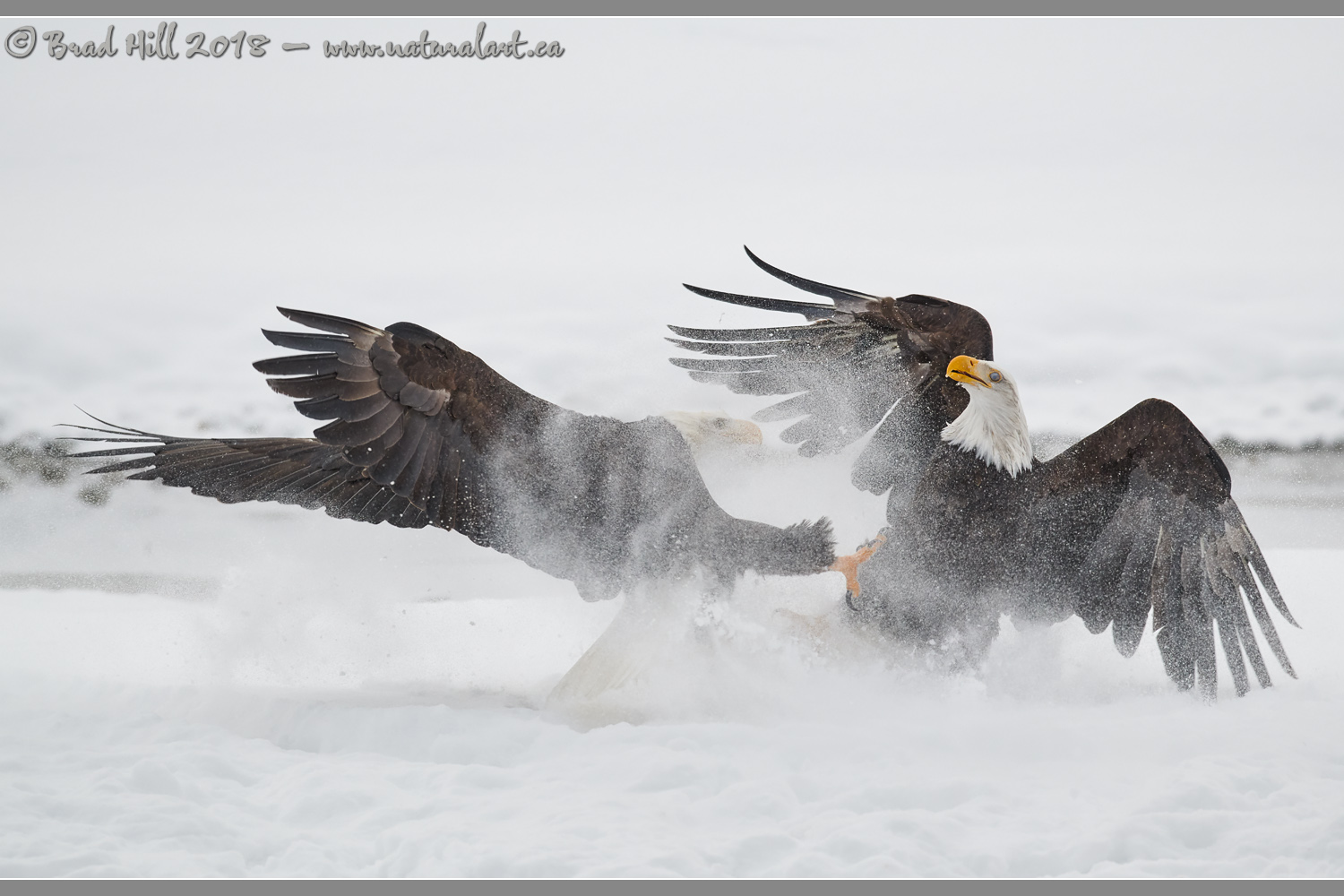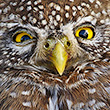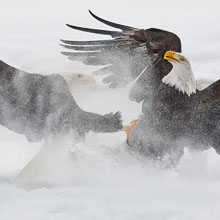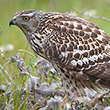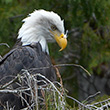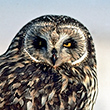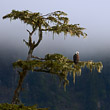Availability: Undetermined - Enquiries?
In the Field
An Old-fashioned Dust-up! Chilkat River, Alaska, USA. November 27, 2017.
What do you get when you find a whole bunch of eagles in an environment where there's a whole lot of fish? Well...because SOME of the eagles will figure it's easier to steal fish from another eagle than it is to haul their own out of the river...ONE thing you get is a whole lot of fighting! In this shot the eagle on the left has decided that it REALLY wants the fish the eagle on the right was feeding on, and it apparently decided the risk of injury (those talons ARE sharp, and they DO use them against one another) is less than the value of the fish. And, in this case, it was right (after a short skirmish it ended up with the fish).
I captured this shot with a Nikon D850. At the time I was shooting a lot of action scenes with this camera and with a Nikon D5. So...how does the D850 stack up as an "action camera"? Well...it depends on how you look at it. For a 46 MP DSLR it's quite impressive as an action camera. And it certainly makes it rivals in the "over 30 MP DSLR" category look pretty bad. And...we already know it's a great landscape camera.
BUT...if you compare it against the BEST of the action cameras from both Nikon and Canon I think the best you can say is "Well...the D850 is...JUST OK for capturing action." In my view the D5 is the absolute top action camera on the market and it beats the D850 considerably in at least 3 critical areas of action camera performance - frame rate, burst size, and the ability of the AF system to initially acquire and track a moving subject. I AM aware that there are ways to increase the burst size of the D850 (my 14 October and my 15 October, 2017 blog entries describe these methods in detail), but if you want the BEST images a camera can produce at its highest frame rate - and for the longest bursts - the D5 and several other Nikon and Canon cameras beat the D850 quite decisively).
So...if you want a great action camera, here's the Nikons I would recommend ahead of the D850 (with best listed first): Nikon D5, D500, D4s, and D4. BUT, if you want a "great all-rounder" that is FANTASTIC for landscape and/or animalscapes and...well...OK for shooting action, then the D850 is the machine for you.
Here's a larger (2400 pixel) version of this dire dust-up:
• An Old-fashioned Dust-up: Download 2400 pixel image (JPEG: 0.90 MB)
ADDITIONAL NOTES:
1. This image was captured during my "Kluane-Haines Explorer" Instructional photo tour in late autumn of 2017. Each year I offer trips into two different parts of the Great Bear Rainforest as well as one to photograph marine mammals and oceanscapes near the northern tip of Vancouver Island. And, in selected years, I also offer photo tours to locations to capture other highly sought-after subjects, such as Dall Sheep, Bald Eagles, and more. Details about these trips can be found on the Photo Tours page of this website.
2. This image - in all resolutions - is protected by copyright. I'm fine with personal uses of them (including use as desktop backgrounds or screensavers on your own computer), but unauthorized commercial use of the image is prohibited by law. Thanks in advance for respecting my copyright!
3. Like all wildlife photographs on this website, this image was captured following the strict ethical guidelines described in The Wildlife FIRST! Principles of Photographer Conduct. I encourage all wildlife photographers to always put the welfare of their subjects above the value of their photographs.
Behind the Camera
An Old-fashioned Dust-up! Chilkat River, Alaska, USA. November 27, 2017.
Digital Capture; Compressed RAW (NEF) 14-bit format; ISO 1100.
Nikon D850 paired with Sigma 500mm f4 Sport lens. Hand-held. OS on and in "OS1" mode, with OS1 stabilization customized to Moderate View mode; AF customized to Fast Priority AF.
1/2000s @ f5.6;+1.33 stop compensation from "recommended" matrix-metered exposure setting.
At the Computer
An Old-fashioned Dust-up! Chilkat River, Alaska, USA. November 27, 2017.
RAW Conversion to 16-bit TIFF, including all global and selective adjustments using Phase One's Capture One Pro 11. Selective local adjustments accomplished using Capture One Pro's layers and masking tools. In this case adjustments were made on 5 separate layers and included local/selective editing or application of exposure, shadow retrieval, colour desaturation, noise reduction and contrast (via a curves adjustment).
Photoshop adjustments were limited to image re-sizing, conversion of Prophoto RGB colour gamut (to sRGB), final sharpening for online display, and insertion of watermark.
Conservation
An Old-fashioned Dust-up! Chilkat River, Alaska, USA. November 27, 2017.
Ten percent of the revenue generated by this image will be donated to Raincoast.
Species Status in Canada*: This species is not designated as at risk. The Bald Eagle was listed as "Endangered" in the contiguous US states from 1967 to 1995. In 1995 it was downlisted to "Threatened". On June 28, 2007 Bald Eagles were removed from the list of endangered and threatened species - a true American conservation success story.
The Bald Eagle (Haliaeetus leucocephalus) is a very large bird of prey with broad wings. Adults possess characteristic white ("bald") heads. It takes Bald Eagles a full five years to attain their characteristic adult plumage (including their nearly pure white head and tail). In the years prior to the development of their adult plumage they are easy to confuse with Golden Eagles. Being very broad-winged Bald Eagles are able to use an energy-efficient flapping-soaring style of flight. While many people like to think of the Bald Eagle as a fierce hunter, in reality they hunt only as a last resort. More commonly they scavenge for their prey. Additionally, they often klepto-parasitize other weaker species such as Osprey, commonly stealing the other species hard-earned prey items. The Bald Eagle is, of course, the national emblem of the United States (Benjamin Franklin argued against this - his preference was for the Wild Turkey).
*as determined by COSEWIC: The Committee on the Status of Endangered Wildlife in Canada













